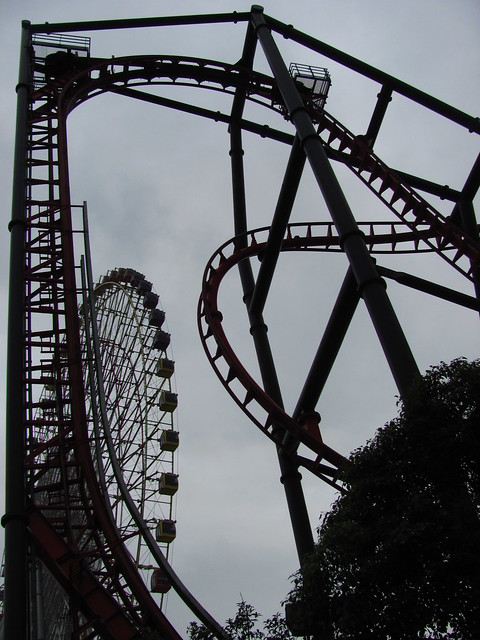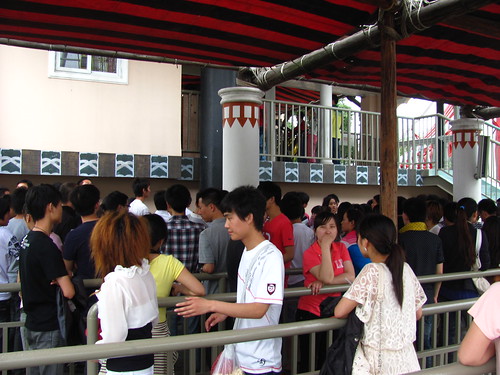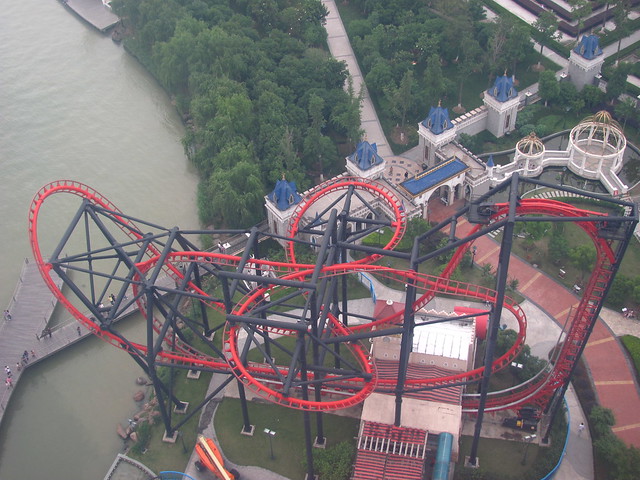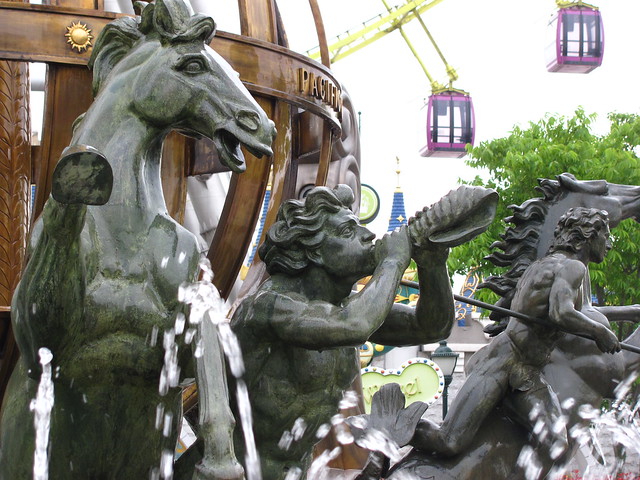Suzhou, Jiangsu, China – Sunday, June 5th, 2011
Which came first, the Giant Wheel of Suzhou or the Park of Suzhou? My money’s on the giant wheel. Ever since the London Eye, giant observation wheels have become a hot commodity with municipal governments looking to build an iconic tourist attraction to put their city on the map. The status and acclaim that comes with opening a giant wheel named after your city is often enough for the city councils to overlook a few fingers pressing on the scales of the project’s economic feasibility study.
When Suzhou wanted to open its 120 meter (394 foot) tall giant wheel along the bank of the Jinji Lake in 2009, they went an unusual extra step by including a small amusement park around the base of it. This seems like not such a bad idea, making the giant wheel more of a visitor destination with a longer length of stay and more opportunities for additional spend. There are relatively few attractions, and the park footprint is so small it could nearly fit in the shadow of the namesake giant wheel. Yet the build quality of the park is pretty good overall, with at least one other attraction besides the enormously costly-to-build giant wheel catching my interest and motivating a visit. Speaking as a visitor on a tight schedule, I wouldn’t mind seeing more of these short-stay parks around the world that focus on doing a couple of things really well and respects my time by skipping the extra fluff.
the base of it. This seems like not such a bad idea, making the giant wheel more of a visitor destination with a longer length of stay and more opportunities for additional spend. There are relatively few attractions, and the park footprint is so small it could nearly fit in the shadow of the namesake giant wheel. Yet the build quality of the park is pretty good overall, with at least one other attraction besides the enormously costly-to-build giant wheel catching my interest and motivating a visit. Speaking as a visitor on a tight schedule, I wouldn’t mind seeing more of these short-stay parks around the world that focus on doing a couple of things really well and respects my time by skipping the extra fluff.
Of course, having some experience in this industry, I can also tell you where the problems with this approach will be. Fewer attractions means lower instantaneous capacity. Both those things require a higher visitor turnover rate throughout the day, which means lower ticket prices to create value and sustain those fast turnstile clicks. Most crucially, shorter lengths of stay mean less in dining and retail sales, which are usually one of the primary drivers of revenue for an attraction. And while the total capital expense is reduced due to the smaller size and fewer attractions, the average outlay per visitor is still going to be similar to what a full day theme park has to spend to attract each additional guest… but again, ticket prices are lower!
tell you where the problems with this approach will be. Fewer attractions means lower instantaneous capacity. Both those things require a higher visitor turnover rate throughout the day, which means lower ticket prices to create value and sustain those fast turnstile clicks. Most crucially, shorter lengths of stay mean less in dining and retail sales, which are usually one of the primary drivers of revenue for an attraction. And while the total capital expense is reduced due to the smaller size and fewer attractions, the average outlay per visitor is still going to be similar to what a full day theme park has to spend to attract each additional guest… but again, ticket prices are lower!
There’s a reason these small but unique “boutique-style” attractions only work in the most highly trafficked tourist corridors, and even then the ticket prices usually have to be pretty exorbitant to sustain it. Building what feels like a nice, laid-back community amusement park around one extremely expensive giant wheel, as well as handful of other relatively expensive attractions and infrastructure, is nice to visit but it’s sure not going to be tough to own.
trafficked tourist corridors, and even then the ticket prices usually have to be pretty exorbitant to sustain it. Building what feels like a nice, laid-back community amusement park around one extremely expensive giant wheel, as well as handful of other relatively expensive attractions and infrastructure, is nice to visit but it’s sure not going to be tough to own.
These facts, along with the park’s eventual closure in 2018, were all far from my mind when I visited Giant Wheel Park of Suzhou in 2011, just two years after it opened. I just got to enjoy the fact that finally there was a park that didn’t require a ton of exploration, just two key attractions that I could quickly hit a short distance from each other and the front gate.
If you’re reading this site, you probably already know the most important of these was not the namesake giant wheel, but the roller coaster built next to it. While the park has only one coaster, it’s probably one of the most unique to have been open in mainland China by June of 2011.
Stingray was the prototype debut of Vekoma’s Stingray compact flying coaster model in 2009. It was the only one of its kind ever built.
After the big and bulky Flying Dutchman failed to take off, Vekoma went back to the drawing board and imagined a compact form of flying coaster that could fit in the footprint of a wild mouse but still deliver some big-time thrills.
With only a single, two-row, eight-passenger train, the ride has a fairly limited capacity. Sure enough, there was a bit of a wait when I arrived.
I decided to occupy my time waiting with some light math. I observed that dispatched only happened about once every 5 minutes. With maybe 12 dispatches per hour and only 8 riders per dispatch (assuming every seat was full), that meant the coaster’s hourly capacity was still in the double-digits. Quite possibly the worst for a coaster this size I’ve ever come across.
It took about an hour, but it didn’t break down and I eventually got to ride.
The coaster starts with a near-vertical lift, the first and still only ever attempted on a flying coaster. It’s actually a really good use of the system, as unlike a standard sit-down coaster where you’re awkwardly laying on your back staring into the sun, on a flying coaster it works a bit like the slow upward climb on a drop tower, as well as to naturally maneuver riders into the flying position. Of course, what comes afterward is much more interesting than the abrupt conclusion of a drop tower.
It starts with a very steep drop which practically functions as an inversion with the flying position. After that there’s a sharp overbanked turn arcing over the lakefront, a great use of the flying configuration.
The middle of the ride is the most intense part of all: an outside half-loop and rollover. If you’ve noticed on flying coasters, every single one that does any portion of a vertical loop (including the pretzel loops on B&M’s flying coasters) puts the vehicles on the inside of the curvature. Stingray is the only one to ever attempt putting riders on the outside of the curvature, and I found the reason why: it’s really intense! The g-forces pulling you out of the harness get really strong, and I can’t imagine it’s good for rider’s necks. But if you’re a hardcore thrillseeker, why not? I doesn’t get much more forceful than this.
The next elements seem like they should be the gentle part of the ride, but looks can be deceiving. Two elevated helices in opposite directions are taken not too fast, but still fast enough that they create some really strong forces around the curve pulling you down against the harness.
Finally, it does a half-loop dive into the brakes. It’s a weird sensation, braking on a descent while you’re essentially upside down, but compared to everything that came before it it’s actually a pretty mellow finish.


 Some more views of Stingray’s tangled mass of track:
Some more views of Stingray’s tangled mass of track:
Stingray turned out to be a pretty fitting name. It’s quick but packs a powerfully aggressive punch. The compact layout is also designed with an almost perfect symmetry that looks a bit like a stingray, or at least some type of flying insect. When viewed from plan view, the overbanked turn makes the head, the twin helices make the wings, and the lift and drop make the stinging tail. I can appreciate this design on its artistic merits in a way that applies to extremely few other Vekoma products.
Normally, a design that can best be appreciated only from a bird’s eye perspective is a bit of a backwards compliment, but here it actually does work with the signature Ferris Wheel towering over the coaster just a short distance away.



 The ride lasts nearly 30 minutes. The park has some useful advice regarding this.
The ride lasts nearly 30 minutes. The park has some useful advice regarding this.
The nearly 400 foot tall Ferris Wheel offers fantastic views of both the small park at its base, as well as the surrounding Jinji Lake and its couple of manmade islands.
With the Ferris Wheel complete, I actually had enough time left to jump back in the queue for a second ride on the Stingray before the park closed for the evening. Afterward I took a brief tour of the remainder of the very small park.
“Don’t linger at the exit.” Alright, then I’ll speed through it post-haste. My time in China was rapidly coming to an end, but I still had one more full day adventure left, and it promised to be a weird one!


















































Too bad they never made another Stingray! I wonder if it was the capacity? Also, do you know what became of this one afther the park closed?
I can’t wait to make my way to Phantasialand and see what the new generation of Vekoma flying coasters is like.
Yeah, I’m going to guess the capacity relative to the cost made the Stingray a not very attractive option for most parks. Plus the G-forces were a little much, possibly going beyond Vekoma’s expectations. I wouldn’t be surprised if they’d want to retool the design before selling another copy, which would be another added expense. Pretty sure this one got recycled after it was taken down, as it never reappeared anywhere.
Bummer about Stingray. It’s one of those models I would really love to try at some point.